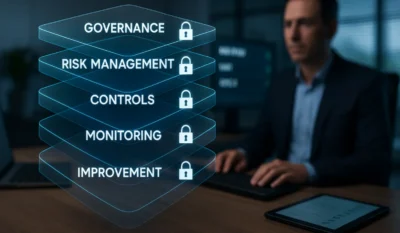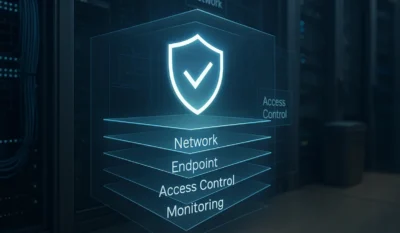If your organization handles sensitive data or relies on digital systems, ask yourself: Do you have an enforceable, up-to-date IT security policy?
72% of enterprises plan to ramp up their cybersecurity spending in 2025, surpassing all other information technology areas. This highlights compliance requirements and the relentless surge of cyber attacks targeting sensitive data and critical information systems.
A well-crafted IT security policy is your first defense, protecting data and aligning controls with your business continuity goals. Far from a static set of rules, this living document includes specific policies, detailed templates, and automation processes that enable your security program to efficiently respond to threats, from malware infiltration to unauthorized remote access.
In this essential guide, you’ll discover how to construct an effective data security policy grounded in the CIA triad principles of Confidentiality, Integrity, and Availability. You’ll also understand the indispensable role a comprehensive Security Operations Center (SOC) and targeted policies play, especially within industries like healthcare, ensuring your organization’s information remains secure and your security posture unshakeable.
Key Takeaways
- Train Employees as Your First Line of Defense: Focus on realistic, scenario-based awareness training.
- Shift from Reactive to Proactive Security: Regularly update and communicate your IT security policies to ensure compliance and protect against evolving threats, avoiding costly fines and damage to your brand reputation.
- Use Compliance as a Competitive Advantage: Align policies with standards like ISO 27001 or HIPAA and leverage compliance certifications to build customer trust and secure new partnerships.
- Invest Strategically in Incident Response Planning: Companies that maintain tested incident response plans save an average of $1.49 million per breach. Prioritize regular plan testing and clear role assignment for rapid incident resolution.
- Conduct Regular Risk Assessments to Guide IT Spending: Perform thorough risk assessments annually to pinpoint security vulnerabilities and strategically allocate your increased cybersecurity budget toward mitigating the most impactful risks.
What is an IT Security Policy?
At its core, an IT security policy defines how your organization approaches information security, clarifies responsibilities, establishes security standards, and ensures accountability. The policy applies broadly to everyone interacting with your IT systems and covers hardware, software, data, networks, cloud services, and even physical security for IT assets. This includes employees, contractors, and vendors.
Without a clear policy, your security efforts become reactive and prone to human error. Verizon’s 2025 report underscores this point, finding that human factors contributed to approximately 60% of all breaches. Policies provide consistent direction and serve as a foundation for strong cybersecurity.
Additionally, an effective security policy interacts with other critical documents:
- Standards: Technical requirements (e.g., passwords must be 12+ characters).
- Procedures: Detailed instructions (e.g., requesting system access).
- Guidelines: Recommendations (e.g., tips for strong passwords).
- Baselines: Minimum required configurations for security systems.
Your IT security policy should be legally enforceable with clear consequences for breaking the rules. This protects your business both legally and day to day.
Why an IT Security Policy is Essential for Every Business
Every organization wants better security, but many underestimate what makes a difference. Firewalls and software alone won’t stop security incidents without clear policies defining behavior, controlling access, and ensuring everyone is accountable.
The following benefits show exactly why every organization needs to take its policy seriously.
1. Risk Mitigation
Identifies vulnerabilities before cyber threats exploit them. IBM noted that the average breach cost in 2024 reached $4.88 million, up 10% from 2023, highlighting the importance of proactive risk management.
2. Regulatory Compliance
Regulations like the Health Insurance Portability and Accountability Act (HIPAA), General Data Protection Regulation (GDPR), Payment Card Industry Data Security Standard (PCI DSS), National Institute of Standards and Technology (NIST), and International Organization for Standardization (ISO) standard 27001 mandate documented policies. These documents demonstrate due diligence, helping avoid hefty fines.
3. Clear Responsibilities
Defines responsibilities from top executives to frontline employees, minimizing confusion and ensuring security tasks are assigned.
4. Decision-Making Framework
Provides clear direction for making technical choices, which helps reduce risky workarounds or shadow IT.
5. Building Security Culture
Educates and empowers staff, making security everyone’s responsibility, thus minimizing human errors like phishing scams and ransomware attacks.
6. Protecting Reputation
Demonstrates your commitment to data protection, maintaining client trust, and protecting your brand from damaging data breaches.
7. Supporting Incident Response
Outlines how to detect, respond to, and recover from security incidents. A structured policy ensures teams act quickly, follow clear communication steps, and minimize damage.
8. Optimizing Investments
Ensures IT investments align with strategic objectives, avoiding redundant and ineffective expenditures.
Key Components of a Comprehensive IT Security Policy
Before you can enforce a strong cybersecurity posture, you need structure. A truly effective information security policy lives in detailed, enforceable sub-policies that address specific risks, users, systems, and processes.
This section breaks down the essential components your organization must document to safeguard sensitive data, control access, and comply with growing regulatory pressures. These components form the operational backbone of your security program, turning plans into clear steps that reduce risk and make your systems stronger.
1. Acceptable Use Policy (AUP)
An AUP outlines the dos and don’ts for employees, contractors, and vendors when interacting with your organization’s information systems. It defines limits on personal use, bans prohibited content, and sets guidelines for software installation.
When these expectations are clearly communicated and consistently enforced, the AUP reduces legal liability, helps prevent misuse, and promotes secure, standardized behavior across all digital environments.
2. Access Control Policy
This policy defines who can access which systems and data, how access is granted and monitored, and how it is revoked. It includes password rules, multi-factor authentication, least privilege principles, and remote access protocols.
This policy minimizes the risk of unauthorized activity and enhances your overall security strategy by restricting access only to those who genuinely need it.
3. Data Classification Policy
A Data Classification Policy categorizes information based on sensitivity levels such as public, confidential, and restricted. It guides how each category should be stored, accessed, shared, and disposed of.
This approach helps staff handle sensitive data appropriately and ensures compliance with privacy regulations and industry standards.
4. Incident Response Policy
An Incident Response Policy defines how your organization will handle cybersecurity incidents, outlining roles, communication steps, response procedures, and recovery plans. Teams react quickly and efficiently with this structure, containing threats, reducing damage, and restoring operations with minimal disruption.
5. Password Policy
A Password Policy sets requirements for creating strong passwords, managing their lifecycle, and storing them securely. It typically includes rules for complexity, expiration, and protection measures.
Since weak passwords are a frequent entry point for attackers, this policy is essential for maintaining system integrity and preventing unauthorized access.
6. Mobile Device Security Policy
The Mobile Device Security Policy governs the secure use of mobile devices, whether company-owned or personal, such as smartphones, tablets, and laptops. It covers encryption, secure connections, remote wipe capability, and approved apps.
As mobile usage grows, this policy helps control data exposure and ensures secure access across a distributed workforce.
7. Network Security Policy
This policy provides a framework for protecting network infrastructure, including guidelines for firewall settings, intrusion detection and prevention systems, Wi-Fi security, and network segmentation. A well-enforced Network Security Policy ensures layered defenses that limit malware spread and block unauthorized movement within the network.
8. Vendor Access Policy
The Vendor Access Policy sets standards for how third parties connect to your systems, what data they can access, and which protections must be in place. This ensures that vendor relationships do not introduce unnecessary risk and that external users meet the exact security expectations of internal teams.
9. Backup and Disaster Recovery Policy
A Backup and Disaster Recovery Policy outlines how frequently data should be backed up, where it is stored, how recovery is tested, and the target recovery time and data loss thresholds. It provides a vital foundation for business continuity and ensures that systems and data can be restored quickly after an outage or cyberattack.
10. Remote Work Policy
The Remote Work Policy establishes secure practices for employees working from home or on the go. It includes requirements for device usage, VPN access, data protection, and physical workspace security.
With remote work now common, this policy helps safeguard information regardless of location and reinforces remote access protocols.
11. Information Asset Inventory Policy
An Information Asset Inventory Policy ensures that all devices, applications, and systems are identified, cataloged, and assigned to responsible owners. By maintaining an accurate inventory, organizations gain better visibility into their IT environment, making managing risk, automating controls, and responding quickly to security incidents easier.
Best Practices for Developing & Implementing an IT Security Policy
Having policies is only half the battle. They must also be well-designed, broadly understood, and consistently enforced to protect your organization’s information assets and meet compliance requirements.
The following best practices ensure your IT security policies become part of your operational DNA.
- Executive Buy-In
Ensure senior leadership visibly supports your security program and actively promotes policy adoption. When executives champion security, the rest of the organization follows.
- Involve Stakeholders
Collaborate with IT, legal, HR, department heads, and end-user representatives to shape realistic, effective, and enforceable policies. Cross-functional input leads to greater buy-in and fewer blind spots.
- Clear and Concise Language
Use plain language so every employee understands and applies the policy. Clarity boosts adherence and reduces accidental non-compliance.
- Align with Business Objectives
Policies should support productivity and growth, not create friction. Align security controls with business goals to gain internal traction and reduce resistance.
- Accessibility
Ensure employees can easily access your policies via intranets, onboarding portals, or Learning Management Systems (LMS). Accessibility drives awareness and accountability.
- Comprehensive Training
Provide engaging, real-world training on every specific policy, emphasizing the why, not just the what. Practical training transforms policies into practiced behaviors.
- Consistent Enforcement
Apply policies fairly across roles and departments. Establish clear, tiered consequences for violations and document disciplinary actions to maintain trust and compliance.
- Regular Reviews
Review and revise policies at least annually or when major shifts occur in your threat landscape, technology stack, or regulatory environment. Stale policies are ineffective policies.
- Document Everything
Maintain detailed records of policy creation, updates, trainings, and incidents. Documentation helps demonstrate due diligence and supports legal defensibility.
- Leverage Frameworks
Use standards like NIST, ISO 27001, and the Center for Internet Security (CIS) Controls to guide your policy structure. These frameworks accelerate policy development and align you with industry best practices.
Keystone: Your Partner in IT Security Policy & Governance
Creating and maintaining robust IT security policies is about building a future-ready foundation for your organization’s security. That takes more than good intentions. It takes deep experience, technical fluency, and an understanding of how to turn compliance requirements into real-world safeguards.
That’s where Keystone IT Security comes in. Our team has a proven record in cybersecurity and IT governance and can deliver customized, audit-ready information security policies that align with your risk profile, industry demands, and business operations.
Whether you’re navigating HIPAA, PCI DSS, NIST, ISO 27001, or other frameworks, we help you build a sustainable security program. From policy development to hands-on implementation, security awareness training, and ongoing monitoring, we close gaps and reduce vulnerabilities before attackers can exploit them.
Partner with Keystone to:
- Rapidly align with compliance frameworks and security standards
- Launch policy programs that stick because they’re built with your people in mind
- Build executive trust by elevating your organization’s security maturity
Let’s create a secure future together. Reach out to Keystone IT Security today for a strategic consultation.
Conclusion
An outdated or generic IT security policy can leave your organization vulnerable to ransomware, compliance violations, and operational breakdowns. If your business relies on information systems, manages sensitive data, or supports a remote workforce, your policies are your greatest defense or your biggest liability.
A customized IT security policy ensures your organization’s security is proactive, not reactive. From defining a remote access policy to protecting sensitive information with precise, enforceable controls, this policy can help you replace uncertainty with clarity, mitigate costly incidents, and gain peace of mind that your cybersecurity efforts support your business.
Schedule a consultation with Keystone IT Security today. We’ll help you build a security program that’s purpose-built for your environment, aligned with your compliance requirements, and equipped to protect your future, starting right now.




